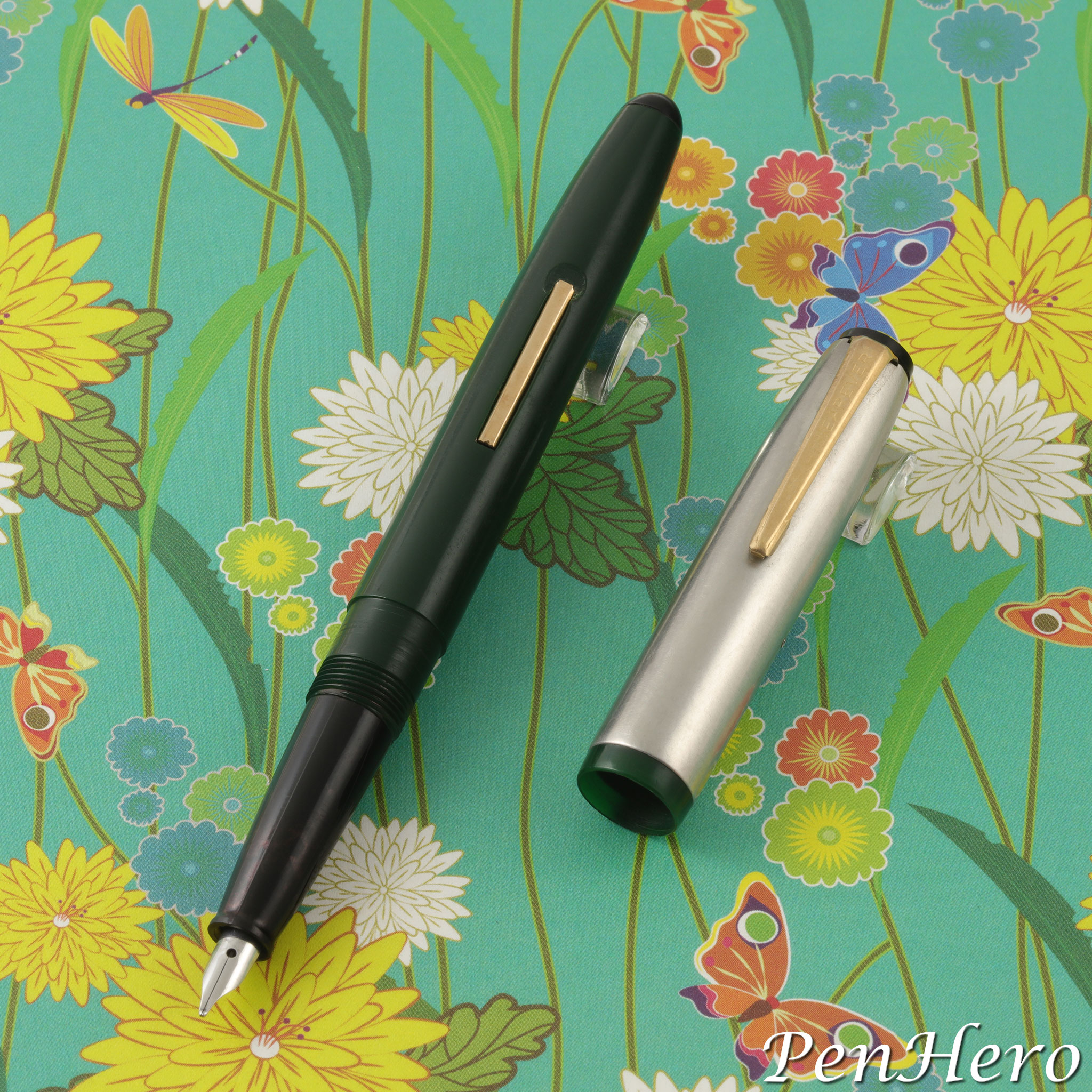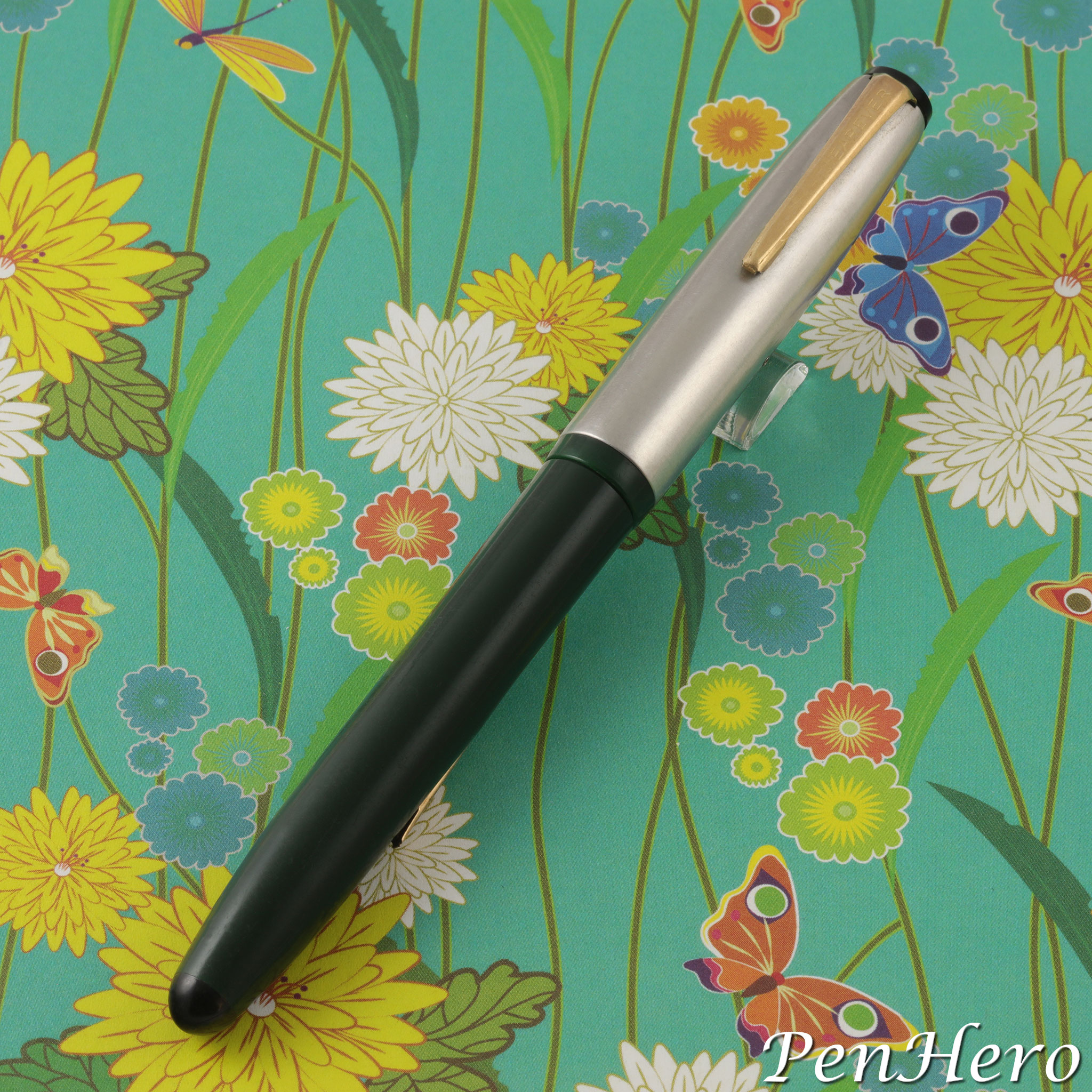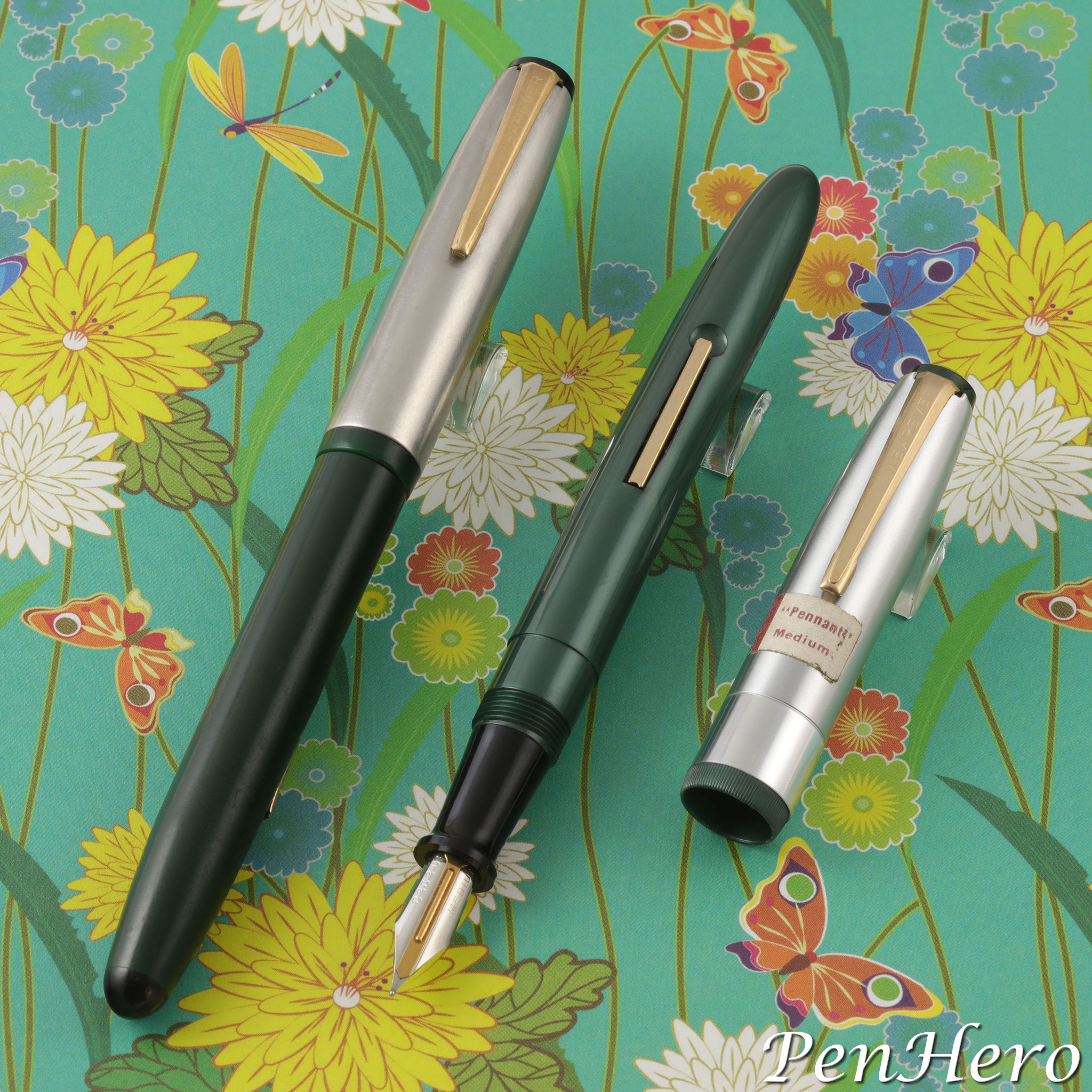Wearever De Luxe 1947-1949
by Jim Mamoulides, November 8, 2024
 Wearever De Luxe green 1947-1949
Wearever De Luxe green 1947-1949
A Wearever Mystery Pen
When I first picked up this pen, I thought it was a Wearever Pennant, probably the most common Wearever in circulation today. If you go pen hunting in the wild, you are bound to see several Pennants. They are easy to spot with their silvery satin finish stainless steel caps, actually a metal sleeve over a plastic inner cap, with WEAREVER stamped on the gold plated clip. This one is different. First, the cap lacks the wide “band” the Pennant has at the bottom. It also lacks the “coin edge” on the plastic cap lip that is typical of the Pennant. Neither of those would be a big deal if removing the cap revealed the familiar Pennant stainless steel nib with its "overfeed.” I would have assumed it was some other iteration of the Pennant. That’s not the case on this pen. It has a long tapering section that ends with a small unmarked stainless steel nib. That is a surprise. So what is it? The imprint is no help. It’s faint, but readable, but unlike many other Wearevers in the 1940s and 50s, it does not reveal the model name.
I stumbled upon the model name for this pen while researching the various pens called Wearever Pacemakers in the 1940s and 50s and discovered one of them, the second version of the Pacemaker, was nearly identical to this pen except the Pacemaker has a 14 karat gold nib. A deeper dive turned up two David Kahn, Inc. company advertisements in the August 30 and September 13, 1947 issues of Collier's Weekly showing images of two new “Back to School” dollar pens, one of them a fountain pen with a stainless steel cap and tapered section called the Wearever De Luxe. Aha! The ad shows the cap with STAINLESS STEEL on the bottom edge and also claims the pen has a flexible point. More on that later on.
 Wearever De Luxe green 1947-1949
Wearever De Luxe green 1947-1949
The first Wearever De Luxe was a large size dash striped celluloid lever filler in three colors, a clip mounted on the front of the cap stamped WEAREVER De Luxe, with a small 14 karat gold nib mounted in a patented white metal reinforcement frame for added strength and sold from 1937 to probably 1940. The first De Luxe may be the best looking Wearever ever made. The De Luxe was redesigned with a top mounted military clip and made with various new celluloids. The earliest ad that mentions this new version was in the June 27, 1941 Des Moines, Iowa Tribune. Examples of the second De Luxe may also be found with the metal framed 14 karat gold nib, or a gold plated stainless steel nib, probably a later change in production.
This third version of the De Luxe was introduced in 1947 and was probably made until 1948 or 1949 when the Pennant was introduced, likely as a its replacement. The Pennant is a very similar pen with a short section and a larger open stainless steel nib that has an overfeed. The cap has some cosmetic changes to the metal cap sleeve, adding a faux band, and to the cap lip, adding a coin edge. The Pennant has a longer clip and no end cap, as the barrel is injection molded as one piece.
There are very few advertisements about this De Luxe, and only a handful with confirming details about the features of the pen. The November 30, 1947 Kansas City, Missouri Star, has a retailer ad that describes the pen having a “Silver Metal Cap” and a “hooded ball point.” A later retailer ad in the August 26, 1948 Vandalia, Missouri Vandalia Press and Laddonia Herald calls the cap stainless steel and describes the clip and lever as gold plated. The latest ad I could find was by a retailer in the August 27, 1950 Kilgore, Texas News Herald, simply saying the pen was for sale for a dollar. Only medium nibs are mentioned in any of the ads I reviewed. After that, the De Luxe appears to have faded into history.
Identification Guide and Features:
 Wearever De Luxe green 1947-1949
Wearever De Luxe green 1947-1949
This third version of the Wearever De Luxe is a lever-fill pen with an injection molded plastic barrel and inner cap. The cap has a satin finish stainless steel sleeve, giving it the appearance of having a metal cap. The cap top and section are black plastic. The section is tapered similar to a late 1940s Waterman Taperite fountain pen and has a small unmarked stainless steel nib. The clip and lever are gold plated. It’s not known how many colors or nib sizes were made, but it’s likely they are the similar colors as the earliest Pennant, in darker shades of maroon, green, navy, and gun metal. The plastic used to make the Pennant was described in David Kahn, Inc. advertisements as Forticel, made by the Celanese Plastic Corporation.
- Injection molded solid color plastic cap and barrel likely in maroon, green, navy, and gun metal – green and maroon are confirmed
- Tapering black plastic nib section
- Black plastic cap top and barrel end cap
- Satin finish stainless steel metal cap sleeve
- Gold plated clip stamped WEAREVER near the top
- Gold plated side lever
- Lever filler
- Threaded cap
- Barrel imprint on three lines: WEAREVER over NORTH BERGEN, N. J. over U. S. A.
- Unmarked stainless steel nib
- Nib grades unknown, medium observed
- About 5 3/8 inches long capped and 6 3/8 inches posted
- Retail price for the fountain pen was $1
- Pen packaging unknown, but likely similar to other Wearever models, including countertop cards and paperboard boxes
- Matching pencil unknown
Performance
Only having one of these is limiting, but Wearevers were consistently enough manufactured that I would expect any other examples of this version of the De Luxe to be similar. This dark green De Luxe is a standard size, about 5 3/8 inches long capped and 6 3/8 inches posted. It's light weight and similar enough to the Pennant visually and in the hand for me to believe this is a precursor model that was redesigned to be the Pennant. It can be used without posting the cap on the end of the barrel, so I left it off for the writing test.
The dark green sample pen photographed for this article needed a new sac. I decided not to replace the sac as I was having some difficulty getting the section off and did not want to break it. I’ve had many Wearever Pennant pens, and they are similar enough to believe this one would fill and work in the same manner, one stroke of the lever, count to twenty, wipe off the nib and section, and the pen would be ready to write. I limited ink testing to dipping the nib.
 Wearever De Luxe green with Wearever Pennant green
Wearever De Luxe green with Wearever Pennant green
The stainless steel nib is unmarked and writes like a medium. The ads for this pen describe them as flexible, but I would call the nib “bendy” at best. Even pressing down harder than I think I should the tines don’t spread nor does the nib provide any real expressiveness or line variation. Calling it flexible is a reach. I don’t have any other examples to try, but I doubt they would be any more flexible than this one. As a soft writing medium, it actually writes well enough to use, though.
Because this De Luxe model was probably made only from 1947 to 1949 that would explain why I’ve only seen very few of them. The name is not stamped on the barrel, so at first, I was not sure what the model was or when it was made. I would guess these pens get identified as Pennants because of the visual similarity. One sample is not enough to say much about fit and finish other than if you’ve handled a Pennant, it would seem familiar and likely have the same good and bad points.
This De Luxe model is uncommon. I think it would take a focused search to find many and some time to locate all the colors. I have no idea how many nib types were offered but would not be surprised if there were at least three or four. If you are seeking out these pens, look for its 14 karat gold nib sibling the Marlboro / Pacemaker. More on those pens in a future article!
References
Advertisement, Collier's Weekly, October 9, 1937, page 68
Advertisement, Collier's Weekly, August 30, 1947, page 44
Advertisement, Collier's Weekly, September 13, 1947 page 95
Advertisement, Des Moines Tribune, Des Moines, Iowa, June 27, 1941, page 3
Advertisement, Life, October 11, 1937, page 13
Advertisement, Life, March 25, 1946, page 44
Advertisement, Life, April 15, 1946, page 18
Advertisement, The Kansas City Star, Kansas City, Missouri, November 30, 1947, page 13
Advertisement, The Kilgore News Herald, Kilgore, Texas, August 27, 1950, page 5
Advertisement, The Vandalia Press and Laddonia Herald, Vandalia, Missouri, August 26, 1948, page 8
Montgomery Ward’s Catalog, 1947, page 57
Interact
Comments on this article may be sent to the author, Jim Mamoulides


